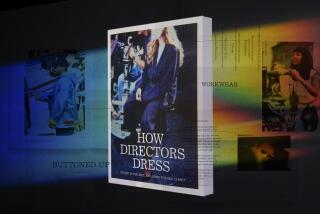Bonnie Cashin; Influential Fashion Designer
- Share via
Bonnie Cashin, one of the most influential designers of American sportswear, died Thursday after open- heart surgery in New York City. She was 84.
Described by fashion experts as an “American sportswear original,” Cashin pioneered a style and way of dressing that still resonate in the work of contemporary designers such as Donna Karan, Calvin Klein and Ralph Lauren.
The hallmarks of her clothes--simple, casual and loose-fitting--can be found today in garments hanging in closets across America. Cashin popularized the layering of lightweight and fluid clothes, which women welcomed in the 1940s and ‘50s as an option to wearing a heavy single dress.
Cashin was among a small group of women who emerged as influential designers after World War II. Until Paris was devastated by the war, French designers had dominated fashion, and it was their original designs that were widely copied by manufacturers.
But that changed as Cashin, Claire McCardell, Anne Klein and Vera Maxwell began to exert influence. Stores in Paris and London even had Cashin departments.
The American designer believed that clothing should be practical and functional. In 1955, Cashin told a reporter, “Fashion evolves from need.” She once described her designs as “articulating with the body.”
She traveled widely and drew heavily from her visits to Asia. The Japanese kimono was her inspiration for layering and detail such as wide sleeves.
Her signature elements were mohair and fine suede, supple leather to pipe edges of coat sleeves and unusual closures such as metal toggles.
She also designed purses for Coach. Her classic designs in the early 1960s included the shoulder bag and a clutch-style purse with a removable shoulder strap.
It was Cashin who made a fashion garment out of the poncho, a style popular today. In the 1960s, she created oversized plaid ponchos with hoods in luxurious fabrics such as mohair and wool and teamed them with plaid, fringed skirts.
Among Cashin’s pioneering designs were a turtleneck that did not require a zipper to get over the head, the kimono coat piped in leather, the hooded jersey dress, the jumpsuit, the snap-closed “pocketbook” pocket, canvas raincoats, soft knee-high boots and the use of industrial zippers.
She is famous for her dog leash skirt: a long wool garment that could be instantly shortened by latching a small brass ring sewn at the bottom to a small brass clasp sewn into the waistline.
In an interview with National Public Radio two years ago, Cashin explained the origin of the skirt. “My studio, out in the country, in Briarcliff, in the old carriage house, had steps that went up to a second floor. And I was constantly holding my skirts going up. I entertained a lot. And I’d be running up stairs with a martini in my hand. And so I thought I’d better hitch my skirt permanently.”
Born in Oakland to a photographer-inventor and a seamstress, Cashin lived in several Northern California towns during her early years before settling in Los Angeles.
Her career began soon after high school, when she joined a Los Angeles ballet company as its designer. In 1934, she moved to New York to work for the Roxy Theater, where she created three costume changes a week for each of the theater’s 24 dancers.
A Variety reporter called Cashin, who was then not yet 20, “the youngest designer ever to hit Broadway.” In her later years, she often credited her talent for designing clothes that moved well with the body to her experience of having to create costumes for dancers.
After the U.S. entered World War II, Cashin designed uniforms for women in the armed forces, but returned to costume design when she moved to Hollywood. She joined 20th Century Fox and created clothes for about 60 films, including, “A Tree Grows in Brooklyn,” “Laura” and “Anna and the King of Siam.”
In 1949, she designed her first sportswear collection for Adler & Adler, a firm in New York City.
She formed her own company, Bonnie Cashin Designs, and soon won the Neiman Marcus and Coty American Fashion Critics awards. She was inducted into the Coty American Fashion Critics Hall of Fame in 1972.
In 1979 she helped found the Innovative Design Fund, a nonprofit foundation, to award grants to “innovative thinkers.” She was included in the 1998 exhibition “American Ingenuity: Sportswear 1930s-1970s” at the Metropolitan Museum of Art’s Costume Institute.
Cashin married Robert Sterner, an art director, early in her career, but they later divorced. She is survived by her longtime companion, Curtis Kellar.






